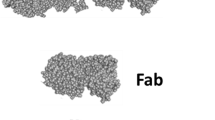Abstract
Objective
We digested anti-MUC1 monoclonal antibody PR81 to produce F(ab′)2 fragments. A comparison was performed between the two radiolabeled PR81 and F(ab′)2 fragments for breast tumor imaging in a mouse model.
Methods
The optimum conditions for pepsin digestion of PR81 were investigated in terms of enzymes: antibody ratio, digestion time duration and preserved immunoreactivity of the produced fragments. The F(ab′)2 fragments were labeled with Technetium-99m using HYNIC as a chelator and tricine as a co-ligand. The immunoreactivity of the complexes was assessed by radioimmunoassay using MCF7 cells. Biodistribution and imaging studies were performed in female BALB/c mice with breast tumor xenograft at 4, 8 and 24 h post-administration. The PR81 was labeled with technetium-99m in the same way for comparison.
Results
The optimum time duration for PR81 digestion was found to be 28 h at an enzyme:antibody weight ratio of 1:20 that resulted in 95.2 ± 4.7% purity. The labeling of intact PR81 and its F(ab′)2 fragments were 87.6 ± 4.2 and 76.1 ± 3.3% after 1 h, respectively (p value <0.05). The percentage of immunoreactivity of F(ab′)2 fragments and intact PR81 were 75.4 ± 2.1% and 85.7 ± 2.9%, respectively (p value <0.05). The biodistribution and imaging studies demonstrated localization of the fragments at 4 h post-administration with high sensitivity and specificity.
Conclusion
The results showed that F(ab′)2 fragment of PR81 is more suitable than intact PR81 for safer and more rapid detection of human breast cancer.




Similar content being viewed by others
References
Al-Ejeh F, Darby JM, Thierry B, Brown MP. A simplified suite of methods to evaluate chelator conjugation of antibodies: effects on hydrodynamic radius and biodistribution. Nucl Med Biol. 2009;36:395–402.
Burvenich IJ, Schoonooghe S, Blanckaert P, Bacher K, Vervoort L, Coene E, et al. Biodistribution and planar gamma camera imaging of (123)I- and (131)I-labeled F(ab′)(2) and Fab fragments of monoclonal antibody 14C5 in nude mice bearing an A549 lung tumor. Nucl Med Biol. 2007;34:257–65.
Salouti M, Rajabi H, Babaei MH, Rasaee MJ. Breast tumor targeting with (99m) Tc–HYNIC–PR81 complex as a new biologic radiopharmaceutical. Nucl Med Biol. 2008;35:763–8.
Lamoyi E, Nisonoff A. Preparation of F(ab′)2 fragments from mouse IgG of various subclasses. J Immunol Methods. 1983;56:235–43.
Abrams MJ, Juweid M, Tenkate CI. Technetium-99m human polyclonal IgG radiolabeled via the hydrazino nicotinamide derivative for imaging focal sites of infection in rats. J Nucl Med. 1990;31:2022–8.
Larsen SK, Caldwell G, Higgins JD, Abram MS, Solomon HF. Technetium complex of tricine: useful precursor for the 99mTc labelling of hydrazino nicotinamide modified proteins. J Label Compd Radiopharm. 1994;35:1–2.
Mather SJ, Ellison D. Reduction mediated technetium-99m labeling of monoclonal antibodies. J Nucl Med. 1990;31:692–7.
Lindmo T, Boven E, Cuttitta F, Fedorko J, Bunn PAJ. Determination of the immunoreactive fraction of radiolabeled monoclonal antibodies by linear extrapolation to binding at infinite antigen excess. J Immunol Methods. 1984;72:77–89.
Pieve CD, Perkins AC, Missailidis S. Anti-MUC1 aptamers: radiolabelling with (99m)Tc and biodistribution in MCF-7 tumour-bearing mice. Nucl Med Biol. 2009;36:703–10.
Schuhmacher J, Klivényi G, Kaul S, Henze M, Matys R, Hauser H, et al. Pretargeting of human mammary carcinoma xenografts with bispecific anti-MUC1/anti-Ga chelate antibodies and immunoscintigraphy with PET. Nucl Med Biol. 2001;28:821–8.
Baum RP, Brümmendorf TH. Radioimmunolocalization of primary and metastatic breast cancer. Q J Nucl Med. 1998;42:33–42.
Albrecht H, Denardo GL, Denardo SL. Development of anti-MUC1 di-scFvs for molecular targeting of epithelial cancers, such as breast and prostate cancers. Q J Nucl Med Mol Imaging. 2007;51:304–13.
Boswell CA, Brechbiel MW. Development of radioimmunotherapeutic and diagnostic antibodies: an inside-out view. Nucl Med Biol. 2007;34:757–78.
Pietersz GA, Wenjun L, Krauer K, Baker T, Wreschner D, McKenzie IF. Comparison of the biological properties of two anti-mucin-1 antibodies prepared for imaging and therapy. Cancer Immunol Immunother. 1997;44:323–8.
Fass L. Imaging and cancer: a review. Mol Oncol. 2008;2:115–52.
Oldham RK, Dillman RO. Monoclonal antibodies in cancer therapy: 25 years of progress. J Clin Oncol. 2008;26:1774–7.
Author information
Authors and Affiliations
Corresponding author
Rights and permissions
About this article
Cite this article
Salouti, M., Babaei, M.H., Rajabi, H. et al. Comparison of 99mTc-labeled PR81 and its F(ab′)2 fragments as radioimmunoscintigraphy agents for breast cancer imaging. Ann Nucl Med 25, 87–92 (2011). https://doi.org/10.1007/s12149-010-0434-2
Received:
Accepted:
Published:
Issue Date:
DOI: https://doi.org/10.1007/s12149-010-0434-2




